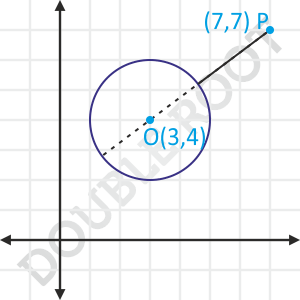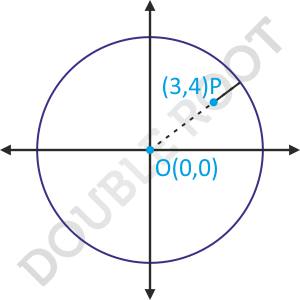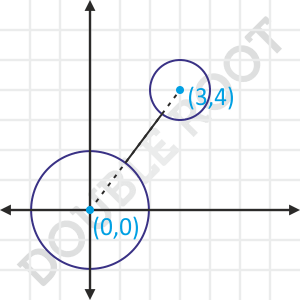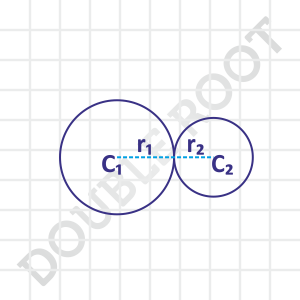This lesson will cover a few examples to illustrate shortest distance between a circle and a point, a line or another circle.
Example 1 Find the shortest and the longest distance between the point (7, 7) and the circle x2 + y2 – 6x – 8y + 21 = 0.
Solution We’ve established all the required formulas already in a previous lesson. Still, have a look at what’s going on.

The shortest distance will be OP – r, i.e. \( \sqrt{(7-3)^2+(7-4)^2} \) – 2 = 3.
We never talked about the longest distance. But I think the figure makes it clear that the longest distance will be OP + r or 7.
What if the point was inside the circle? Let’s consider this case in the next example.
Example 2 Find the shortest distance between the point (3, 4) and the circle x2 + y2 = 36.
Solution Observe that the point lies inside the circle. (I’ve talked about this here). Now if you apply the formula OP – r straight away, you’ll get a negative answer, i.e. 5 – 6 = – 1. This is due the fact that the point lies inside the circle and r > OP. Have look at the figure.

Therefore, the distance in this case will be r – OP, instead of OP – r. To get rid of this small issue, we can simply use the formula |OP – r|, without worrying about the position of the point with respect to the circle.
Let’s talk about the distance between a line and a circle now.
Example 3 Find the shortest distance between the line 3x + 4y + 5 = 0 and x2 + y2 – 6x – 8y + 24 = 0.
Solution As discussed earlier, the shortest distance between a line and a circle will be the perpendicular distance of the line from the centre of the circle, minus the radius.
The radius of the circle is 1. And the distance of the line from the centre of the circle is 6. Therefore, the shortest distance will be 6 – 1 = 5.
Make sure the line does not touch or intersect the circle. In that case, the shortest distance will be zero.
In such cases, if you calculate using the above formula straight away you’ll either get zero or negative answers. Zero is okay. But a negative answer in this case means that OP < r, which means the line intersects the circle, and the shortest distance will be zero.
Go back here to find the position of a line with respect to a circle.
Now let’s move on to finding the distance between two circles.
Example 4 Find the shortest distance between the circles x2 + y2 = 4 and x2 + y2 – 6x – 8y + 24 = 0.
Solution The centres of the two circles are (0, 0) and (3, 4) respectively, and their radii are 2 and 1 respectively. Here’s a figure to illustrate.

The figure shows that the two circles do not intersect or touch each other. But I’m not convinced. Maybe the figure isn’t accurate, and also, I do not wish to draw figures every time to confirm. So how do we ensure their relative position?
Observe the distance between their centres, which equals 5. Also, have a look at their radii: 2 and 1. In case the two circles touched each other, then the distance between their centres would have been equal to the sum of their radii. Makes sense?

What if we move them away from each other? In that case the distance between their centres will increase, and become greater than the sum of their radii. And that is exactly what’s happening in the example here – the distance between the centres (5) is greater than the sum of the radii of the two circles (1 + 2).
Now that we’re convinced that the circles don’t intersect each other, we can safely use the formula C1C2 – r1 – r2 = 5 – 2 – 1 = 2 as the shortest distance.
Example 5 Find the shortest distance between the circles x2 + y2 = 25 and x² + y² – 4x – 4y + 7 = 0
Solution In this case, one of the circles lies inside the other, something which I was talking about towards the end of the previous lesson.

The shortest distance here equals r1 – C1C2 – r2 (have a close look at the figure, to figure out).
Now the distance between the centres here is 2 , and their radii r1 and r2 are 5 and 1 respectively. That gives us the shortest distance as 4 – 2\(\sqrt{2}\) .
And that’ll be all about normals, and shortest distances. Next, I’ll talk about relative position of two circles and common tangents to two circles.